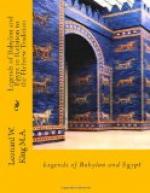Thirdly, Larak he gave to Pabilkharsag,
Fourthly, Sippar he gave to the hero, the Sun-god,
Fifthly, Shuruppak he gave to “the God of Shuruppak",—
After he had called
the names of these cities, and they had
been allotted to divine
rulers(?),
(1) In Semitic-Babylonian
the first component of this city-
name would read “Dur”.
The completion of the sentence, in the last two lines of the column, cannot be rendered with any certainty, but the passage appears to have related the creation of small rivers and pools. It will be noted that the lines which contain the names of the five cities and their patron gods(1) form a long explanatory parenthesis, the preceding line being repeated after their enumeration.
(1) The precise meaning
of the sign-group here provisionally
rendered “divine
ruler” is not yet ascertained.
As the first of the series of five cities of Eridu, the seat of Nudimmud or Enki, who was the third of the creating deities, it has been urged that the upper part of the Second Column must have included an account of the founding of Erech, the city of Anu, and of Nippur, Enlil’s city.(1) But the numbered sequence of the cities would be difficult to reconcile with the earlier creation of other cities in the text, and the mention of Eridu as the first city to be created would be quite in accord with its great age and peculiarly sacred character as a cult-centre. Moreover the evidence of the Sumerian Dynastic List is definitely against any claim of Erech to Antediluvian existence. For when the hegemony passed from the first Post-diluvian “kingdom” to the second, it went not to Erech but to the shrine Eanna, which gave its name to the second “kingdom”; and the city itself was apparently not founded before the reign of Enmerkar, the second occupant of the throne, who is the first to be given the title “King of Erech”. This conclusion with regard to Erech incidentally disposes of the arguments for Nippur’s Antediluvian rank in primitive Sumerian tradition, which have been founded on the order of the cities mentioned at the beginning of the later Sumerian myth of Creation.(2) The evidence we thus obtain that the early Sumerians themselves regarded Eridu as the first city in the world to be created, increases the hope that future excavation at Abu Shahrain may reveal Sumerian remains of periods which, from an archaeological standpoint, must still be regarded as prehistoric.
(1) Cf. Poebel, op. cit., p. 41.
(2) The city of Nippur does not occur among the first four “kingdoms” of the Sumerian Dynastic List; but we may probably assume that it was the seat of at least one early “kingdom”, in consequence of which Enlil, its city-god, attained his later pre-eminent rank in the Sumerian pantheon.
It is noteworthy that no human rulers are mentioned in connexion with Eridu and the other four Antediluvian




